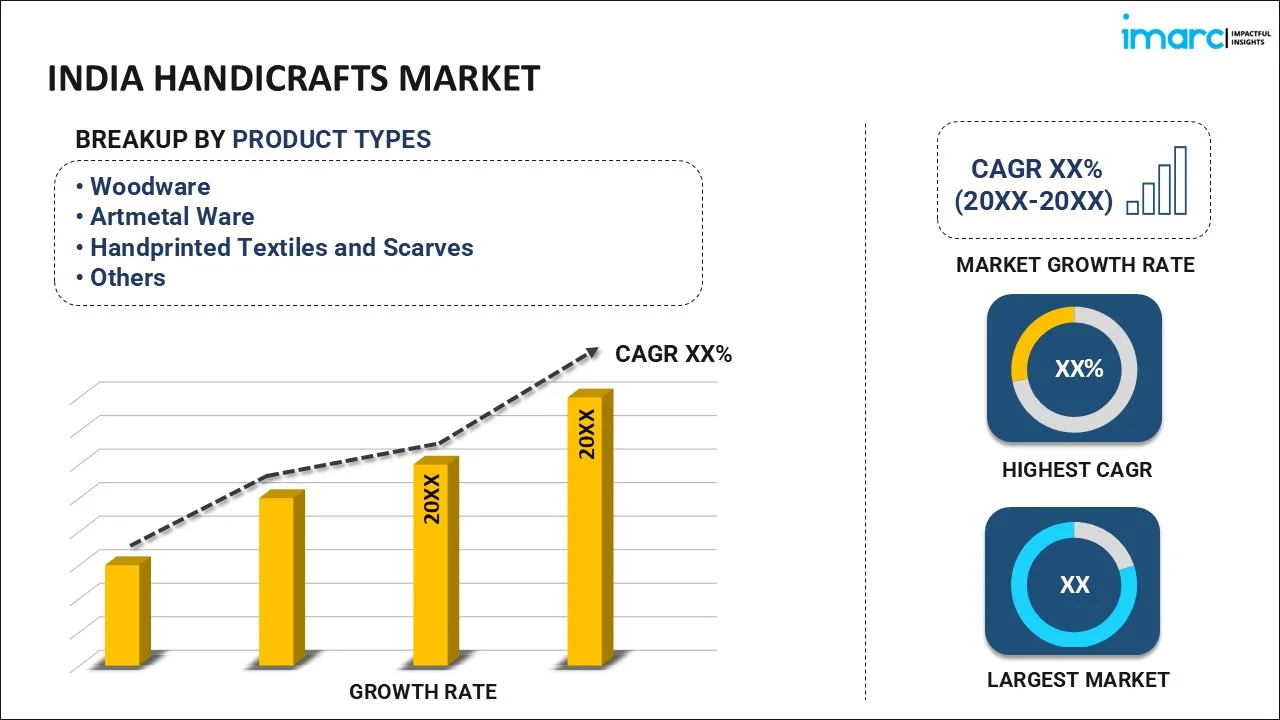
India Handicrafts Market Report by Product Type (Woodware, Artmetal Ware, Handprinted Textiles and Scarves, Embroidered and Crocheted Goods, Zari and Zari Goods, Imitation Jewelry, Sculptures, Pottery and Glass wares, Attars and Agarbattis, and Others), Distribution Channel (Mass Retailers, Departmental Stores, Independent Retailers, Specialty Stores, Online Stores, and Others), End Use (Residential, Commercial), and Region 2025-2033
Market Overview:
The India handicrafts market size reached USD 4,565.0 Million in 2024. Looking forward, IMARC Group expects the market to reach USD 8,198.5 Million by 2033, exhibiting a growth rate (CAGR) of 6.39% during 2025-2033.
|
Report Attribute
|
Key Statistics
|
|---|---|
|
Base Year
|
2024
|
|
Forecast Years
|
2025-2033
|
|
Historical Years
|
2019-2024
|
|
Market Size in 2024
|
USD 4,565.0 Million |
|
Market Forecast in 2033
|
USD 8,198.5 Million |
| Market Growth Rate 2025-2033 | 6.39% |
Handicrafts refer to unique artifacts that are either handmade or made using simple tools instead of machines. They represent the traditional, cultural and artistic values of a place or nation. As they add aesthetic and decorative value, their demand is escalating across India.
Significant advancements in the accessibility of handicraft products on various online portals are strengthening the market growth in India. Besides this, handicrafts are gaining immense popularity due to the increasing travel and tourism in the country. Tourists spend a considerable amount on purchasing souvenirs and other craft items, thereby expanding the scope for local artisans and craftsmen to produce and sell efficient handicrafts. Moreover, the escalating demand for handmade décor accessories in homes, offices and restaurants, along with the increasing demand from the gifting industry, is propelling the market growth. Furthermore, the inflating disposable incomes and the increasing willingness among individuals to invest in vintage and high-quality handicraft products are impelling the market growth in the country.
Key Market Segmentation:
IMARC Group provides an analysis of the key trends in each sub-segment of the India handicrafts market report, along with forecasts at the country and regional level from 2025-2033. Our report has categorized the market based on product type, distribution channel and end use.
Breakup by Product Type:

- Woodware
- Artmetal Ware
- Handprinted Textiles and Scarves
- Embroidered and Crocheted Goods
- Zari and Zari Goods
- Imitation Jewelry
- Sculptures
- Pottery and Glass wares
- Attars and Agarbattis
- Others
Breakup by Distribution Channel:
- Mass Retailers
- Departmental Stores
- Independent Retailers
- Specialty Stores
- Online Stores
- Others
Breakup by End Use:
- Residential
- Commercial
Breakup by Region:
- North India
- West and Central India
- South India
- East India
Competitive Landscape:
The competitive landscape of the industry has also been examined along with the profiles of the key players.
Report Coverage:
| Report Features | Details |
|---|---|
| Base Year of the Analysis | 2024 |
| Historical Period | 2019-2024 |
| Forecast Period | 2025-2033 |
| Units | Million USD |
| Segment Coverage | Product Type, Distribution Channel, End Use, Region |
| Region Covered | North India, East India, West and Central India, South India |
| Customization Scope | 10% Free Customization |
| Post-Sale Analyst Support | 10-12 Weeks |
| Delivery Format | PDF and Excel through Email (We can also provide the editable version of the report in PPT/Word format on special request) |
Key Questions Answered in This Report
The India handicrafts market was valued at USD 4,565.0 Million in 2024.
We expect the India handicrafts market to exhibit a CAGR of 6.39% during 2025-2033.
The expanding travel and tourism industry, along with the growing prominence of handicraft items as souvenirs, owing to their uniqueness and the essence of vibrant art and culture, is primarily driving the India handicrafts market.
The sudden outbreak of the COVID-19 pandemic has led to the changing consumer inclination from conventional brick-and-mortar distribution channels towards online retail platforms for the purchase of handicraft products across the nation.
Based on the product type, the India handicrafts market can be divided into woodware, artmetal ware, handprinted textiles and scarves, embroidered and crocheted goods, Zari and Zari goods, imitation jewelry, sculptures, pottery and glass wares, attars and agarbattis, and others. Currently, woodware holds the majority of the total market share.
Based on the distribution channel, the India handicrafts market has been bifurcated into mass retailers, departmental stores, independent retailers, specialty stores, online stores, and others. Among these, mass retailers currently exhibit a clear dominance in the market.
Based on the end use, the India handicrafts market can be segmented into residential and commercial. Currently, the residential sector accounts for the largest market share.
On a regional level, the market has been classified into North India, West and Central India, South India, and East India.
Need more help?
- Speak to our experienced analysts for insights on the current market scenarios.
- Include additional segments and countries to customize the report as per your requirement.
- Gain an unparalleled competitive advantage in your domain by understanding how to utilize the report and positively impacting your operations and revenue.
- For further assistance, please connect with our analysts.
 Inquire Before Buying
Inquire Before Buying
 Speak to an Analyst
Speak to an Analyst
 Request Brochure
Request Brochure
 Request Customization
Request Customization




.webp)




.webp)












